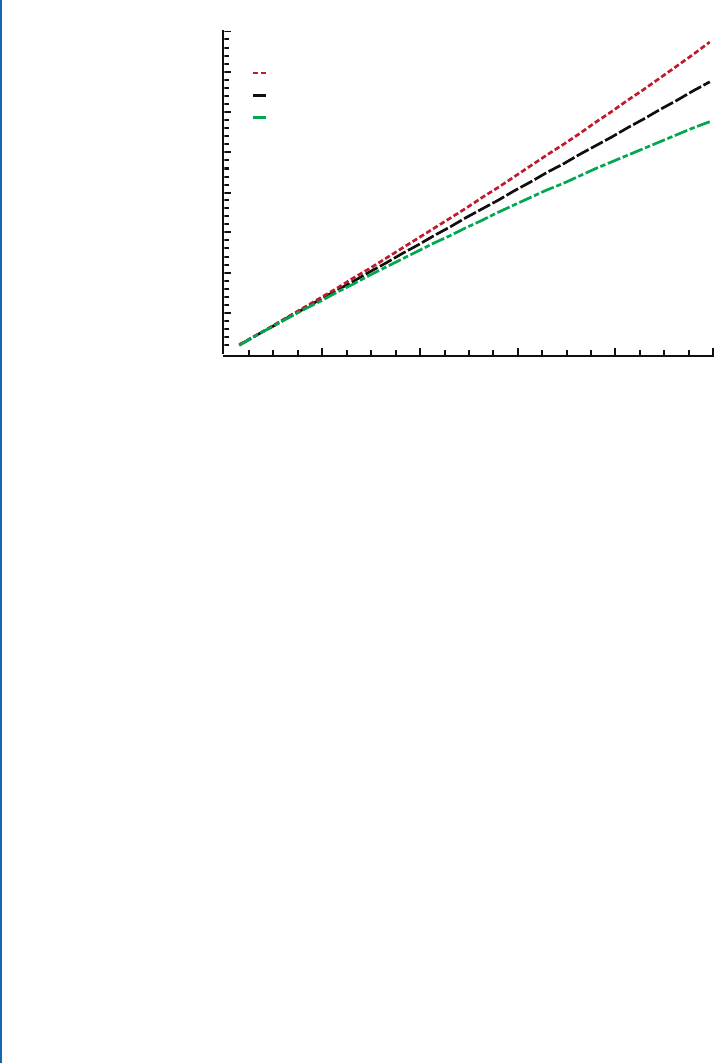
89
C H A P T E R 6
e Past
6.1 MEASURING THE HISTORY OF THE UNIVERSE
e concept of look-back time allows us to record a history of the expansion of the universe. e
Hubble parameter gives us the current expansion rate of the universe; if we extend the Hubble
diagram of Figure 5.1 to vast distances, we sample that expansion rate further and further back
in time.
e greater the slope of the Hubble diagram, the faster the universe expands. If, for ex-
ample, the slope is greater for very large distances, it means the universe was expanding faster
in the distant past. e opposite would be true if the slope turns out to be smaller at large dis-
tances. See Figure 6.1 for examples of Hubble diagrams that compare a constant expansion rate
to hypothetical universes that were expanding either more slowly or more rapidly in the past.
In practice, cosmologists do not directly plot v vs. d . Instead the directly observed redshift,
z, is used instead of a velocity calculated from the Doppler effect formula. Although a simple
Doppler effect interpretation of the cosmological redshift is convenient for relatively small dis-
tances, it is not really correct when one considers the details of an expanding universe. And
so cosmologists use detailed cosmological models to predict the relationship between redshift
and some observable quantity that relates to distance. e predictions from the models are then
compared directly to the observations.
6.2 THE BEGINNING
If we take the observed expansion of the universe at face value—that it means the universe was
once much hotter and denser, this implies there was a beginning to the universe we now observe,
a t D 0 when the temperature and density was infinite. What came before? One may speculate
(and many do), but such speculations are not really part of what we call big bang cosmology.
And so we imagine the universe expanding from infinite temperature and density, cooling
and becoming less dense with the passage of time. is basic idea has been fleshed out in quite
a bit of detail over the past few decades. One could now even go so far as to say that it actually
makes a fair amount of sense. e Big Bang is intriguing because it explains, with surprisingly
few assumptions, four key overall features of the present universe:
1. e universe is made up of 3/4 Hydrogen and 1/4 Helium, with only traces of everything
else put together. Note that this refers only to normal matter.

90 6. THE PAST
0
1.0x10
4
2.0x10
4
3.0x10
4
4.0x10
4
5.0x10
4
6.0x10
4
7.0x10
4
8.0x10
4
0 200 400 600 800 1,000
Expansion Rate Faster in Past
Expansion Rate Constant
Expansion Rate Slower in Past
d (Mpc)
v (km/s)
Figure 6.1: e Hubble diagram for different possible universes. e straight-line black curve
shows a universe expanding at a constant rate. e red line shows a universe that was expanding
faster in the past—and so the curve is more steeply sloped at large distances (greater look-back
time). is is what one would expect with ordinary gravity slowing the expansion over time. e
green line shows the opposite, an accelerating universe expanding more rapidly in the present
than the past.
2. e universe has a finite age. at is, there is a maximum age to the stuff we see in the
universe.
3. e universe is expanding in a uniform way, as shown by the observation of Hubble’s law.
4. e universe is currently filled with a uniform radiation, at a temperature of 2:77 K—the
CMB.
In addition, the Big Bang has recently made a fair amount of progress in connecting
smoothly with other theories that try to explain the following.
1. e way that galaxies, galaxy clusters, superclusters, and large-scale structure developed in
the universe.
2. Some properties of the mysterious dark matter.
3. e nature of the fundamental laws of physics and how they relate to each other in a unified
way.
..................Content has been hidden....................
You can't read the all page of ebook, please click here login for view all page.
